1993 BUICK REGAL overheating
[x] Cancel search: overheatingPage 106 of 308
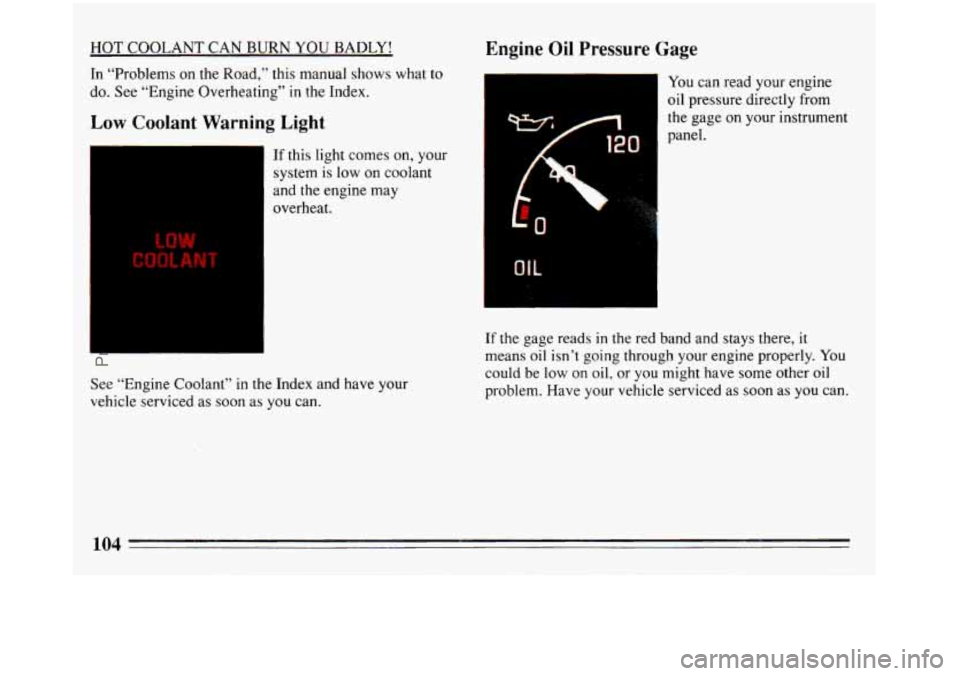
HOT COOLANT CAN BURN YOU BADLY!
In “Problems on the Road,” this manual shows what to
do. See “Engine Overheating”
in the Index.
Low Coolant Warning Light
If this light comes on, your
system is low
on coolant
and the engine may
overheat.
See “Engine Coolant” in the Index and have your
vehicle serviced as soon
as you can.
Engine Oil Pressure Gage
OIL
I
You can read your engine
oil pressure directly from
the gage on your instrument
panel.
If the gage reads in the red band and stays there, it
means oil isn’t going through your engine properly.
You
could be low on oil, or you might have some other oil
problem. Have your vehicle serviced as soon as you can.
ProCarManuals.com
Page 176 of 308
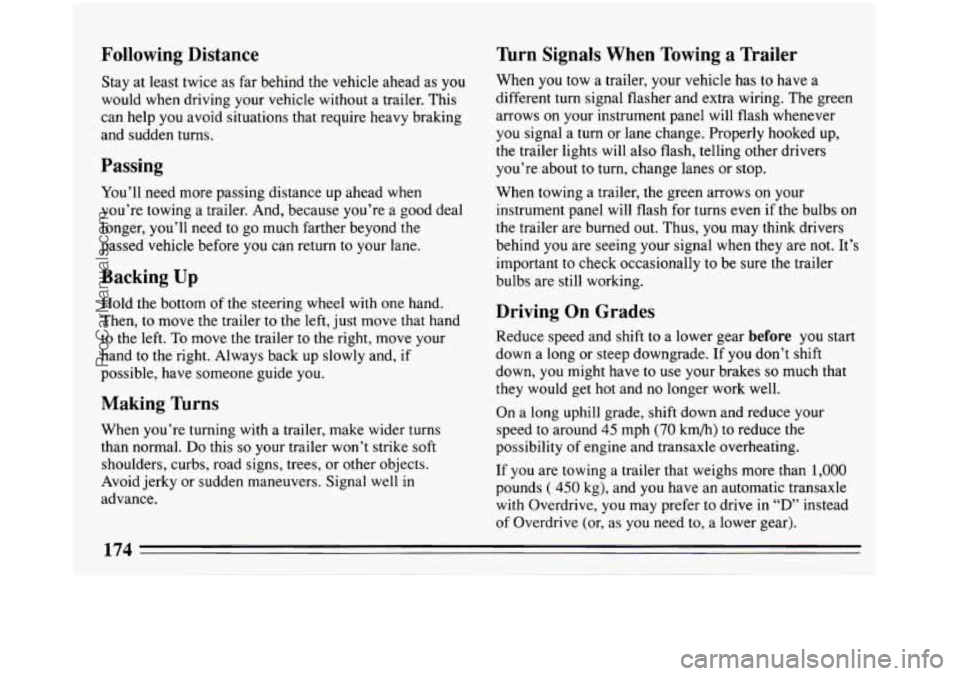
Following Distance
Stay at least twice as far behind the vehicle ahead as you
would when driving your vehicle without a trailer. This
can help you avoid situations that require heavy braking
and sudden turns.
Passing
You’ll need more passing distance up ahead when
you’re towing a trailer. And, because you’re a good deal
longer,
you’ll need to go much farther beyond the
passed vehicle before
you can return to your lane.
Backing Up
Hold the bottom of the steering wheel with one hand.
Then, to move the trailer to the left, just move that hand
to the left. To move the trailer to the right, move your
hand to the right. Always back up slowly and, if
possible, have someone guide you.
Making Turns
When you’re turning with a trailer, make wider turns
than normal.
Do this so your trailer won’t strike soft
shoulders, curbs, road signs, trees, or other objects.
Avoid jerky or sudden maneuvers. Signal well in
advance.
firn Signals When Towing a Trailer
When you tow a trailer, your vehicle has to have a
different turn signal flasher and extra wiring. The green
arrows on your instrument panel will flash whenever
you signal a turn or lane change. Properly hooked up,
the trailer lights will also flash, telling other drivers
you’re about to turn, change lanes or stop.
When towing a trailer, the green arrows
on your
instrument panel will flash for turns even if the bulbs on
the trailer are burned out.
Thus, you may think drivers
behind you are seeing your signal when they are not.
It’s
important to check occasionally to be sure the trailer
bulbs are still working.
Driving On Grades
Reduce speed and shift to a lower gear before you start
down a long or steep downgrade. If
you don’t shift
down, you might have to use your brakes
so much that
they would get hot and no longer work well.
On a long uphill grade, shift down and reduce your
speed to around
45 mph (70 km/h) to reduce the
possibility of engine and transaxle overheating.
If you are towing a trailer that weighs more than
1,000
pounds ( 450 kg), and you have an automatic transaxle
with Overdrive, you may prefer to drive in
“D” instead
of Overdrive
(or, as you need to, a lower gear).
174
ProCarManuals.com
Page 179 of 308

Part 5 Problems On The Road
Here you’ll find what to do about some problems that can occur on the road .
Part 5 includes:
Hazard Warning Flashers
........................................................
QtherWarningDevices .........................................................
“Jump”Starting ...............................................................
TowingYourBuick ............................................................
Engineoverheating ............................................................
IfaTireGoesFlat .............................................................
ChangingaFlatTire ............................................................
CompactSpareTire ............................................................
If You’re Stuck in Sand, Mud, Ice or Snow ..........................................
...
...
...
...
...
...
...
...
...
178
179
180
185
192
201
201
210
211
ProCarManuals.com
Page 194 of 308
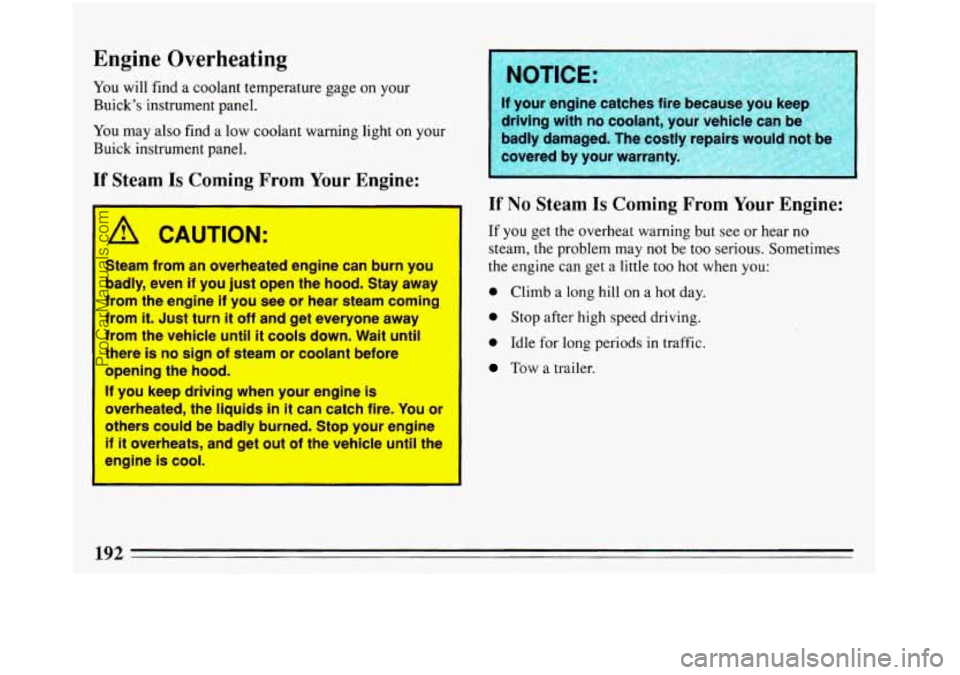
Engine Overheating
You will find a coolant temperature gage on your
Buick's instrument panel.
You may also find a low coolant warning light
on your
Buick instrument panel.
If Steam Is Coming From Your Engine:
A CAUTION:
Steam from an overheated engine can burn you
badly, even
if you just open the hood. Stay away
from the engine
if you see or hear steam coming
from it. Just turn
it off and get everyone away
from the vehicle until it cools down. Wait
until
there is no sign of steam or coolant before
opening the hood.
'* -7ou keep driving when your engine is
overheated, the liquids
in it can catch fire. You or
others could be badly burned. Stop your engine
if it overheats, and get out of the vehicle until the
engine is cool.
If your engine catch
driving with
no coolant, your vehicle can be
badly damaged. The costly repairs
w?uld not b
covered by your warranty. ,, , 1 ,.
I If No Steam Is Coming From Your Engine:
If you get the overheat warning but see or hear no
steam,
the problem may not be too serious. Sometimes
the engine can get a little too hot when you:
0 Climb a long hill on a hot day.
0 Stop after high speed driving.
0 Idle for long periods in traffic.
Tow a trailer.
ProCarManuals.com
Page 196 of 308
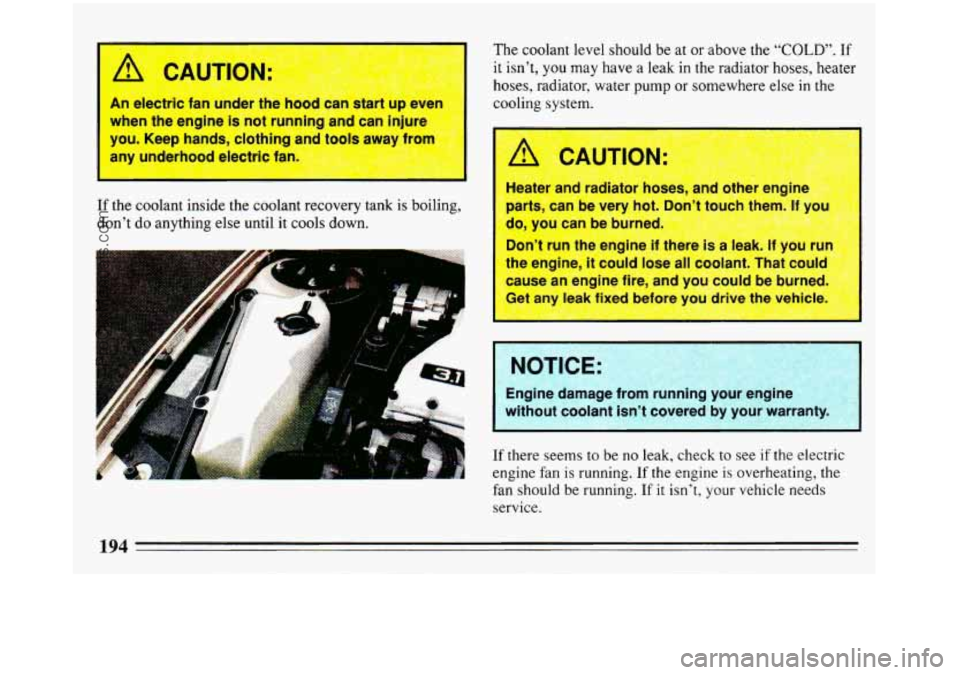
tder the hood can =&drt up even
is not running and can injure
--, clothing and tools away frnm
I nlcwtric fan-
~ ~~~~ ---
If the coolant inside the coolant recovery tank is boiling,
don’t do anything else until it
cools down. The
coolant level should be at or above the
“COLD”. If
it isn’t, you may have a leak in the radiator hoses, heater
hoses, radiator, water pump or somewhere else
in the
cooling system.
9
Heater and radiator hoses, and other englne
parts, can be very hot.
do, you can be burned.
Don’t run the engine
if there is a leak. If you r,,,
the engine, it could lose all coolant. That could
cause an engine fire, and you could be burned
my leak fixed before you drive +he vehicl,.
I U
If there seems to be no leak, check to see if the electric
engine fan
is running. If the engine is overheating, the
fan should be running.
If it isn’t, your vehicle needs
service.
194
ProCarManuals.com
Page 230 of 308
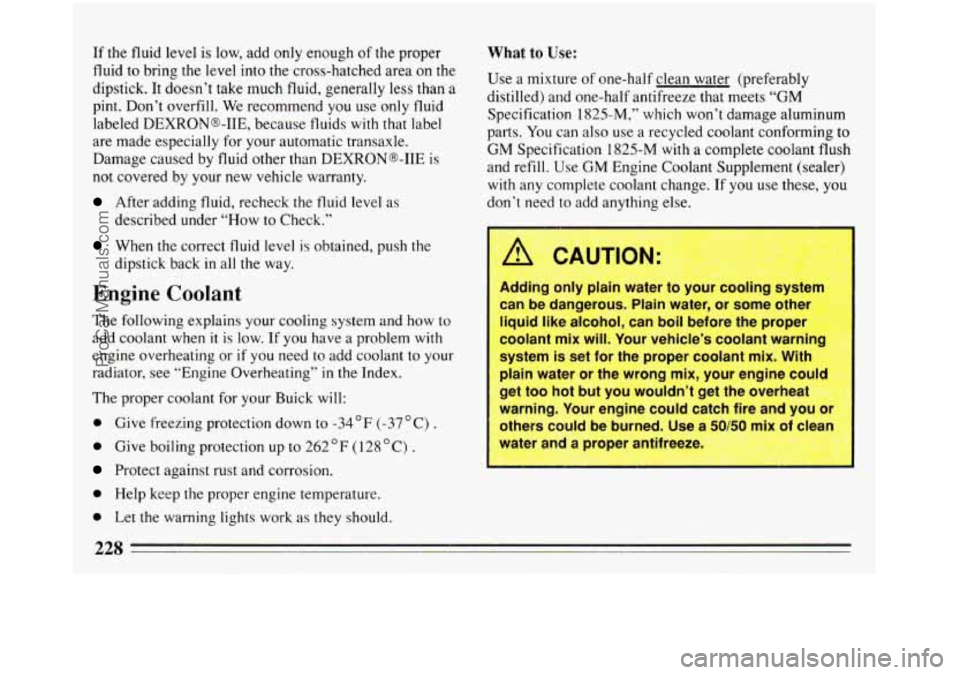
If the fluid level is low, add only enough of the proper
fluid to bring the level into the cross-hatched area on the
dipstick. It doesn’t take much fluid, generally less than a
pint. Don’t overfill. We recommend you use only fluid
labeled DEXRONB-IIE, because fluids with that label
are made especially for your automatic transaxle.
Damage caused by fluid other than DEXRONB-IIE is
not covered by your new vehicle warranty.
After adding fluid, recheck the fluid level as
described under “How
to Check.”
When the correct fluid level is obtained, push the
dipstick back in all the way.
Engine Coolant
The following explains your cooling system and how to
add coolant when
it is low. If you have a problem with
engine overheat.ing or if you need to add coolant to your
radiator, see “Engine Overheating”
in the Index.
The proper coolant for your Buick will:
0 Give freezing protection down to -34OF (-37OC) .
0 Give boiling protection up to 262 OF (128 “C) .
Protect against rust and corrosion.
0 Help keep the proper engine temperature.
0 Let the warning lights work as they should.
What to Use:
Use a mixture of one-half clean water (preferably
distilled) and one-half antifreeze that meets
“GM
Specification 1825-M,” which won’t damage aluminum
parts. You can also use a recycled coolant conforming to
GM Specification 1825-M with a complete coolant flush
and refill. Use GM Engine Coolant Supplement (sealer)
with any complete coolant change. If you use these, you
don’t need to add anything else.
can be aangerous. Plain water, or some other
liquid like alcohol, can boil before the proper
coolant mix will. Your vehicle’s coolant warning
system is set for the proper coolant mix. With
plain water or the wrong mix, your engine could
get too hot but you wouldn’t get the overhe-”
warning. Your engine could catch fire and
yuu or
others could be burned. Use a 50/50 mix of clean
water and a proper antifreeze.
G:~Z.+T~:, p:.t+d+s
228
ProCarManuals.com
Page 233 of 308
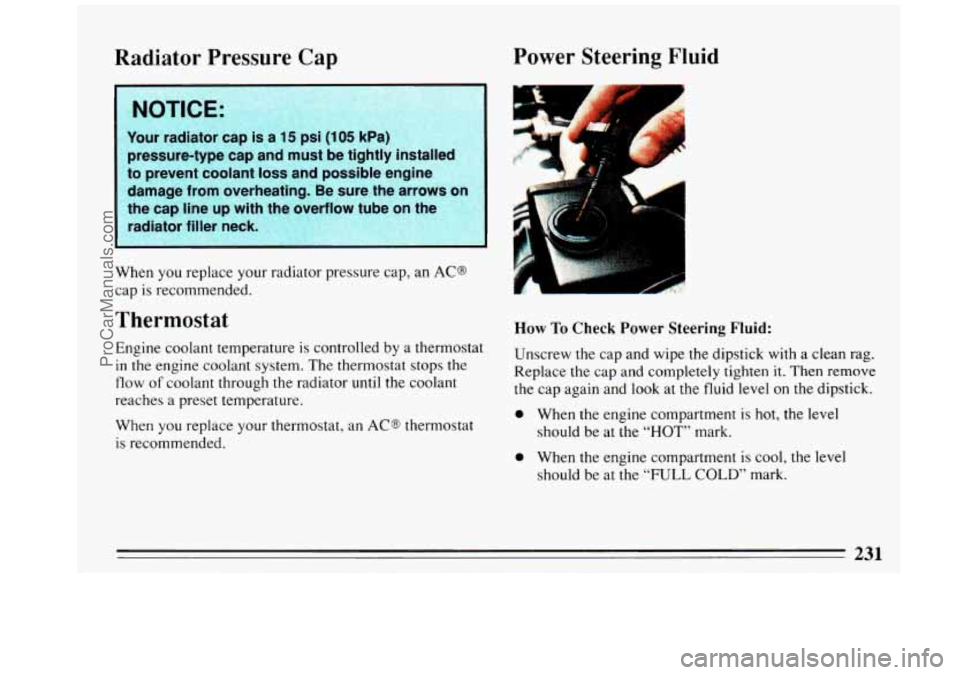
Radiator Pressure Cap rower Steerlng Fluid
1; NOTICE: 1
.:: Your radiator cap is a 15 psi (1 05 kPa)
:: pressure-type cap and must be tightly installed
,*to prevent coolant loss and possible engine
q:. damage from overheating. Be sure the arrows on
,. the cap line up with the overflow tube on the
8: radiator filfer neck.
When you replace your radiator pressure cap, an AC@
cap is recommended.
Thermostat
Engine coolant temperature is controlled by a thermostat
in the engine coolant system. The thermostat stops the
flow of coolant through the radiator until the coolant
reaches a preset temperature.
When you replace your thermostat, an
AC@ thermostat
is recommended.
L
How To Check Power Steering Fluid:
Unscrew the cap and wipe the dipstick with a clean rag.
Replace the cap and completely tighten
it. Then remove
the cap again and look at the fluid level on the dipstick.
0 When the engine compartment is hot, the level
should be at the
“HOT” mark.
0 When the engine compartment is cool, the level
should be at the
“FULL COLD” mark.
231
ProCarManuals.com
Page 243 of 308

A CAUTION:
Poorly maintained and improperly used tires are
dangerous.
0
Overloading your tires can cause
overheating as a result
of too much
friction. You could have an air-out and a
serious accident. See “Loading Your
Vehicle”
in the Index.
Underinflated tires pose the same danger
as overloaded tires. The resulting accident
could cause serious injury. Check all tires
frequently to maintain the recommended
pressure. Tire pressure should be checked
when your tires are cold.
Overinflated tires are more likely to be cut,
punctured, or broken by
a sudden impact,
such as when you
hit a pothole. Keep tires
at the recommended pressure.
Worn, old tires can cause accidents.
If your
tread
is badly worn, or if your tires have
been damaged, replace them.
Inflation - Tire Pressure
The Tire-Loading Information label which is on deck lid
shows the correct inflation pressures for your tires, when
they’re cold. “Cold” means your vehicle has been sitting
for at least three hours or driven
no more than a mile.
241
ProCarManuals.com